“The St Bees Man and the Medieval Way of Death”
Lecture text by Dr John Todd M.A. of St Bees.
We reproduce here the text of the talks delivered (in various forms) at; the Post-Graduate Seminar on Medieval History, Lancaster University, 8th May 1985; Copenhagen University Medieval Centre, 22nd September 1987; Oxford University Medieval Society, 24th January 1991; St. Andrews University Archaeological Society, 3rd May 1995; and Cumbria Theological Society, 22nd May 1996.
Note that since then further advances have been made forensically and by historical research. (Note added 2021)
Introduction
Since, in my own corner of Cumbria, I have acquired a certain notoriety, as the man who shows the nearest thing in historical studies to video nasties, I must begin with a disclaimer. I didn’t jump into this line of studies: I was pushed. There I was, minding my own business in the law and starting to edit the Lanercost Cartulary, when along comes this nice archaeologist to dig in my home village, St. Bees. Deirdre O’Sullivan she’s called, now of Leicester University. So my wife Mary and I were drawn in to provide historical backing for a series of excavations intended to reveal pre-Norman activity around St. Bees Priory. They didn’t; but that’s another story.
I would also like to stress that what I’m going to say and show owes a lot to the work of others – Deirdre, Mary, Eddie Tapp and the other doctors involved, and the groups at Lancaster, Copenhagen and Oxford Universities – and the bee-keepers of Drigg, and the members of just about every Women’s Institute in West Cumbria – who have discussed earlier versions of this paper.
St Bees Priory
The Priory was founded between 1120 and 1135, a cell of St. Mary’s Abbey, York. The monks took over an existing church with roots in the pre-Viking past: it was the home of a holy relic used for oath-taking and healing, the ring of St. Bega. The church has a fine Romanesque west door. By 1300, the full group of buildings may have looked something like this. Today, the church remains in use, nearly intact, but the last of the domestic ruins around the cloister were levelled about 1815.
1981 was the third year of excavations at St. Bees, and, because the site of the work done in the 1979 and 1980 seasons was wet and impossibly expensive to pump, Deirdre, with our encouragement, decided to dig on the site of an aisle on the south side of the chancel. Architectural evidence suggests that the aisle was added after 1290, and was abandoned before the Priory was dissolved in 1539. Today, it’s a no-man’s-land, not part of the churchyard, and it’s as near the church as you can get.
So digging began. The floor level of the chancel aisle was found a metre down, showing a wholly unexpected slope in the natural ground. Burials, from the periods before and after the aisle was built, were revealed in another metre’s depth of disturbed levels below the floor. With one exception, all were skeletons.
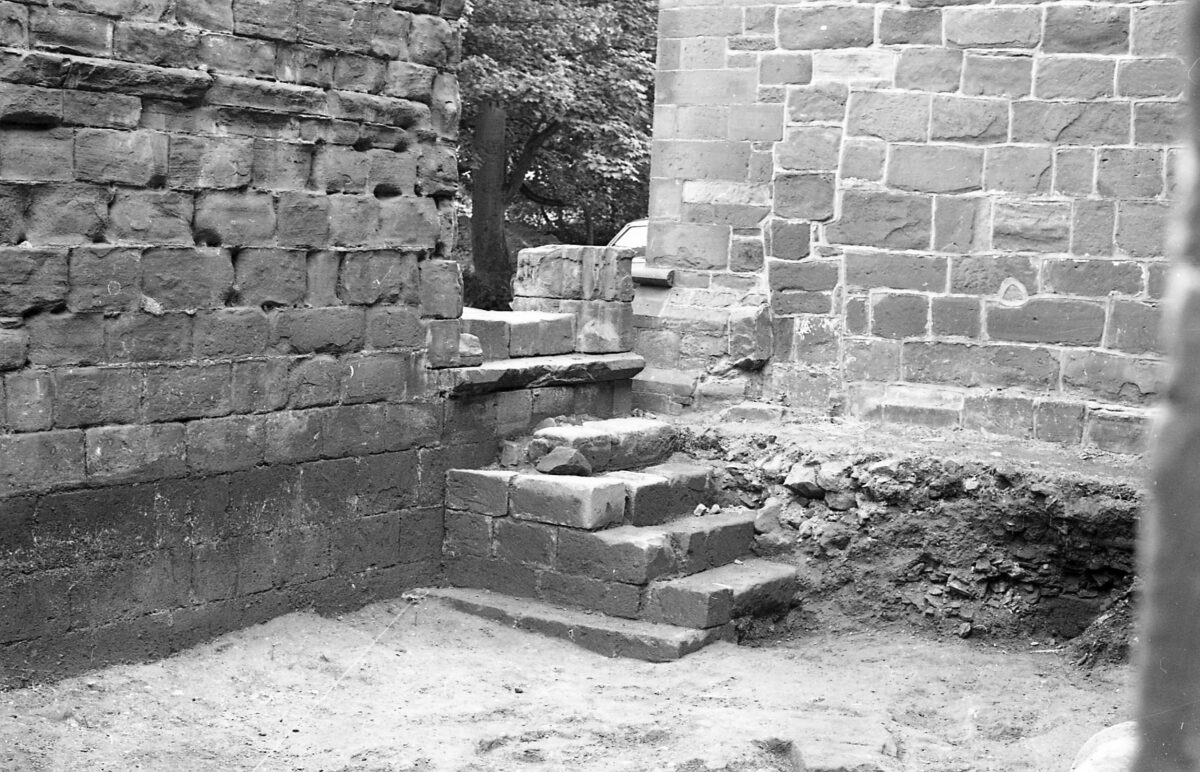
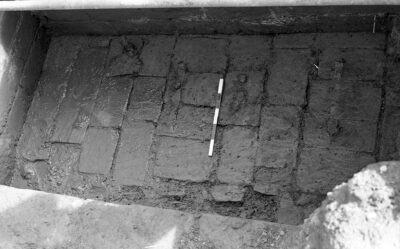
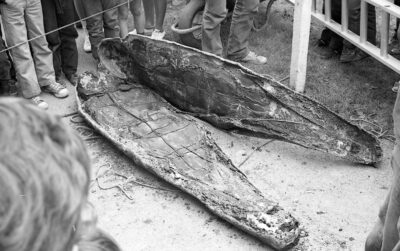
The discovery
The exception was in the mid-line of the aisle. In front of where the altar once stood, a structure emerged, clearly a vault, but without its capping of paving slabs or effigy. Then there appeared traces of iron, next the stains of the wood of a box clamped with the iron, then clay packing, and finally a smooth, hard shell of lead – not so much a coffin as a wrapper shaped to the body inside. In the vault, beside the lead, was a woman’s skeleton. The vault itself was a pit, lined with good ashlar, about a metre and a half wide, and at least two metres long (the wall at one end could not be exposed). The southern side, under the lead wrapper, was paved. The northern side was not. A straight join in the stonework at the exposed end showed that the vault had been extended after its original construction, presumably to take the woman’s body. Since the earth fill of the vault was homogeneous, it had not been filled at all until after the second burial. There were pottery sherds in the earth, probably dating from the fourteenth century, though one could have come from the fifteenth.
Now lead coffins are not unknown in medieval digs, but so far the contents have always been skeletal or slimy. No more was expected of this one, especially since the lead was punctured at the foot. So it was opened. But what was within was neither bony nor slimy. Neatly parcelled with twine and linen was a body which had all the apparent solidity of one not long dead. Helpfully in attendance, the village doctor said: `There’s only one refrigerator big enough for that’. Equally helpful, the village undertaker took him to it (on the pickup). So a strange party arrived at the mortuary of the West Cumberland Hospital that evening. And a man with a form to fill in asked questions. `Name of deceased?’ `Not known.’ `Date of Death?’ `Well, some time between about 1290 and 1500.’ `I see. Next of kin?’ `Pass.’ `Cause of death.’ `Pass.’ And so it went on.
Thanks to the Department of the Environment, which made an emergency grant within forty-eight hours, a palaeopathologist was obtained. Dr. Edmund Tapp of Preston Royal Infirmary, who had unwrapped a mummy or two, came north with his colleague Dr. Owen and a team of helpers. The autopsy lasted two days, after which, incidentally, `our brother unknown’ was reverently reburied in the chancel aisle.
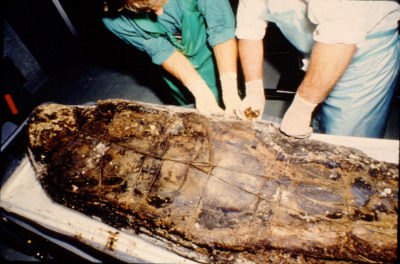
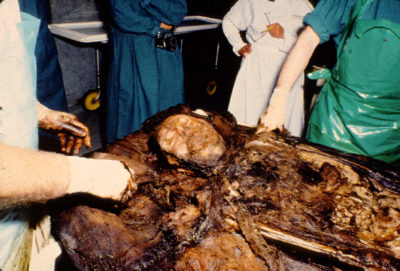
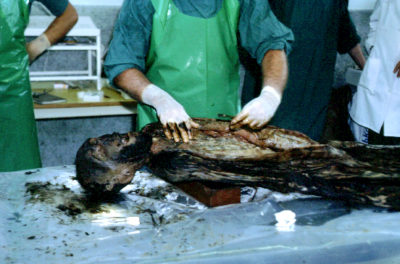
The Post-Mortem
The first task at the post-mortem was to take the body out of the lower part of the lead wrapper. The next was to undo the shroud. This turned out to be two thicknesses of plain linen. It was coated with a dark resinous substance which the Chorley Forensic Laboratories identified as `probably beeswax’. The inner shroud had a strip torn off, very clumsily and presumably in haste, to make a loincloth, the body’s only clothing.
The outer shroud had a tasselled decoration on one end. The flesh of the body was stained and encrusted where it had been in contact with the shroud. But where it had not been in contact, it was of a good pink colour, which faded to a yellowish brown. Except for the fungus on the right leg, there were few visible signs of decay.
The arm, when raised, was neither brittle nor soggy. So the doctors made their incisions, and were soon exclaiming: `my, look at that aorta: no heart problems there’. All the internal organs were present and intact. In fact, it took several hours to convince the medical men that this body had not been buried as some kind of medical student’s hoax a couple of days before.
The precise causes of death remain a matter of speculation, and the local coroner was not interested in holding an inquest. X-rays had already revealed certain injuries: a fracture of the jaw caused by a blow from the right side, a fracture of the seventh rib, and a fracture of the hyoid bone in the neck. All of these appeared to have arisen shortly before death, since there was no sign of any regeneration of the bone. Dr. Tapp believes, however, that the immediate cause of death was a condition known as haemothorax. Blood, probably from a small puncture, had flooded the right lung cavity, and the lung had collapsed. As you can see, a considerable quantity of blood was still liquid. Death could have struck our knight down suddenly while on horseback – whether in battle, tournament, or a riding accident we do not know.
The man had short hair, going grey, and a beard. There was a tight cord round his neck, but the doctors concluded he had not been strangled. Longer human hair had been arranged round his neck, and this was, surprisingly, found to be of different colour and texture from the man’s own hair. His teeth (and other indicators) showed that he was about forty years of age. The teeth were much worn, more worn than is usual even in most medieval skeletons, and the dental expert who reported on them wondered whether he had seen service in the Middle East and eaten more than a peck of sand with his bread. He had a nasty abscess caused by a botched attempt to remove one of the teeth. This otherwise healthy man must have been in constant pain.
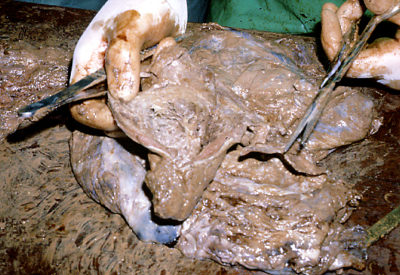
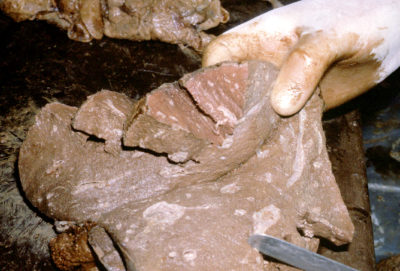
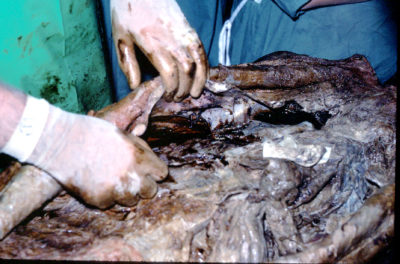
Preservation of the body
The doctors concluded that the exceptional preservation of the St. Bees body owed nothing to better-known techniques of preservation, drying, embalming with aloes, incense, myrrh and musk, and the removal of the heart and other soft organs. Disembowelling is recorded for Henry I and was a normal practice before the great aristocratic funerals of Tudor and Stuart times. Nor was preservation due to burial in exceptionally wet, acid conditions – as with Lindow Man and many other bog bodies – or to exceptional dryness – as with Egyptian mummies. No, it was due to the combined effects of the lead sheath, which excluded moisture, and the beeswax coating on the shroud, which excluded all air. Under such conditions, hydrolysis of the neutral fats of the body tissues took place, changing them to fatty acids which were deposited as crystals in the tissues. These chemical changes acidified and dehydrated the tissues, so killing off the bacteria which normally cause decay, and producing glycerol which acted as a preservative. The slide shows the crystalline nodules on the lining of the chest. These were at first suspected to be tubercular (and that emptied the mortuary of onlookers): how was anyone to know whether the TB bacillus might remain active for over 500 years? *
There are many questions which such a discovery brings to mind. Who was the man? How unusual was the manner of his burial? And, most important for the present audience, why was he so preserved – what was the stock of ideas about death and burial in the people of his day? *
Identity of the man
First, then, who was `our brother unknown’? This has been the principal part of the research which has fallen to my wife and me, and we are still trying to fill in the mortuary clerk’s form. Remember that the systematic recording of births and deaths did not begin until 1538, and one has to scratch up whatever evidence is going. There is no time to tell you the whole detective story: I can only sketch out the line of reasoning we have followed together.
We are looking for a man aged forty, give or take five years or so, buried after 1290 and before the chancel aisle went out of use around 1500. Even after fifteen years, Deirdre has not been able to provide any radio-carbon dates. The closest dating is by the pottery sherds in the fill of the vault: they were mostly of fourteenth-century pottery, with possibly one sherd of the fifteenth century. With the man was buried a woman, so he was presumably a layman. The vault was enlarged to take her body some time after his – so we deduce that she was either his widow or some heiress who succeeded to his lands. The vault, of good ashlar, in a prominent position, on the mid-line of the chancel aisle, in front of the altar, suggests a man of some status, with good reason to claim burial at St. Bees – a patron (i.e. a lord who was the successor to the founder’s estates) or a benefactor.
These boundaries would still leave us searching an impossibly wide field. To reduce the ground to be covered, we have to make an assumption, namely that one of the three known male tomb effigies at St. Bees represents the man in the vault. One was of wood, and fell prey to rot or beetles between 1777 and 1816. The other two survive, if you call these mere torsos of weathered stone survival. Fortunately, however, an intelligent clerk took an hour off to sketch at St. Bees in 1665, when the effigies were in much better condition. The clerk was Gregory King, amanuensis to Sir William Dugdale, then on a herald’s visitation at Egremont. My slide does not do justice to King’s draughtsmanship. King’s caption shows that the wooden effigy was in the chancel, not the chancel aisle, and it can therefore be excluded from our enquiry. In the chancel aisle where the body was found, were the other two effigies: one wore chain-mail and carried a fretty shield, and the other had no heraldic bearings, was wearing mainly plate armour, and was holding something remarkably like a chalice. Philip Lankester, of the Royal Armouries, is of the opinion that the first effigy would not be later than 1320, making due allowance for the time-lag in styles and old stock in masons’ yards. The second belongs to the decades 1360-1380. The chalice, if that is what it is, is unique and unexplained.
Fretty shields appear to offer a fruitful line of investigation. They were carried by six Cumbrian families, of which four, Curwen, Fleming, Hudleston and Harrington, produced benefactors of the Priory. Applying the tests of age, death around the dates indicated by the armour of the effigy, and whether the family in question habitually buried its members elsewhere, we come up with one man who is most likely to have been buried under the older effigy, namely Robert of Harrington. His coat was sable fretty argent, and he was buried at St. Bees in 1298, as the Chronicle of St. Mary’s Abbey records. The Harringtons were a rising family, and Robert’s marriage to Agnes of Cansfield brought him estates in Furness. Robert’s son John, possibly in emulation of his father, built a chancel aisle at Cartmel Priory, died in 1348, and was buried there in a sumptuous tomb. The effigy with the fretty shield may very well be that of Robert of Harrington: he probably had something to do with the erection of the St. Bees chancel aisle, and was buried there. But it is less likely that he was the man in the vault. Agnes of Cansfield died before her husband, and there is no record that Robert re-married. We presume that the woman in the vault was buried later than the man. We move on to consider the second effigy, c. 1360-80. We cannot conclusively rule out members of a number of families. But some evidence points in the direction of Anthony de Lucy, last lord of Cockermouth of that name, who died in 1368.
Anthony de Lucy
Anthony held one-third of the estates of Moulton of Egremont, divided between co-heiresses in 1334. The Egremont barony carried with it the patronage of St. Bees Priory. The county historians Nicholson and Burn record in 1777 a tradition that Anthony de Lucy was buried at St. Bees, and we have records of the burial there of two other members of his family. Anthony was no older than 38 when he died. His wife survived him, and died in 1403. She had been married before, and married yet again, and that might be thought to rule out the possibility that she would be buried in the grave of her second husband. There is at least one other instance of this: Lady Wenlock in the fifteenth century requested burial with Sir John Fray, to whom she had previously been married twenty years before. In any event, the female skeleton in the vault could also be that of Anthony’s sister Maud, who succeeded to most of his lands and died in 1390. Either wife or sister could account for the finding of that single sherd of later pottery in the vault.
The circumstances of Anthony de Lucy’s death turned out to be quite well-documented. He succeeded to his father’s estates in 1365 and took over his father’s duties on the West March. These were times of tension and truce on the Borders, with continuing negotiations over the ransom of David II. Safe conducts for merchants and others on the Rotuli Scotiae seem to show an easing of tension in 1367, when articles of peace were agreed at Moorhouselawe.
Anthony took his chance and went abroad, with fifteen horsemen and £500 for expenses, borrowed from Alice Perrers, `Edward III’s gold-digging mistress’, in McFarlane’s memorable phrase. Anthony’s licence to travel does not show his destination, but in the same week as it was issued, his distant cousin John of Moulton also borrowed from Alice, and he was going to la Pruce, Prussia. And in the Spring of 1368, the Prussian Chronicle of Wigand of Marburg records a party of Englishmen assisting the Teutonic Knights against the heathen Slavs in the long-running northern crusade. Wigand does not mention Anthony or John of Moulton by name, but he does mention a Lord Bemunt (Anthony’s stepmother was a Beaumont) and Nortz Vewater (Anthony’s cousins were FitzWalters). Anthony never returned home. The Inquisition post Mortem merely says that he died abroad. A fifteenth-century roll of the Greystoke family states that he died in the Holy Land. Did Anthony travel on there from the marches of Prussia, or did the Greystoke chronicler, knowing only that he died on a crusade, jump to the conclusion that the crusade was in Palestine? At least his salvation was assured: as the contemporary writer on chivalry, Honore Bonet, says: `If a knight die in a war ordained by the church … and not otherwise in mortal sin, his soul goes forthwith to paradise.’
Anthony de Lucy’s status as a crusader is consistent with a number of observed features. The Teutonic Knights, like the Hospitallers, might well have been the sort of intelligent people who would have sheets of beeswax-coated linen ready to wrap round their more distinguished casualties. If Anthony had taken crusading vows to expiate some sin – as others did – this would help to explain the rope round his neck, which we have taken as a sign of penitence. One thinks of the young King Henry, son of Henry II, who on his deathbed had himself laid naked on ashes, a stone for a pillow, a rope round his neck. If Anthony died in a holy cause, this might even help to explain the chalice on the effigy – if that is what it is. Again, the unusual circumstances of his death might explain why, as we shall see in a moment, there are so few other well-preserved bodies. On the other hand, is it not unlikely that anyone would go to the trouble of transporting the great weight of lead-wrapped, clay-packed, boxed body all the way back from the Baltic or the Mediterranean?
There, for the moment, we rest our case: but new evidence, documentary or archaeological, could well set us searching again. If we knew where the lead was mined, or where the pollen in the beeswax grew, it might be possible to clinch the argument, but so far the best that the laboratories at Manchester University have been able to tell us is that the lead of the coffin is not similar to other lead samples from St. Bees, and does not appear to be typical of other lead samples from elsewhere in the U.K. *
Unusual circumstances
The second question to be discussed is how unusual is this burial? In one respect it is probably unique: we believe that on no previous occasion has there been a full autopsy upon a preserved body from the Middle Ages. The only recent report of a preserved body of this period is that of the brief examination in 1969 of the remains of Archbishop Godfrey de Ludham (d. 1265) in York Minster. There was a lead coffin, but no shroud. The flesh had hydrolysed to adipocere, but was far less complete than at St. Bees. It was not possible to say whether embalming had been attempted. For circumstances of burial close to those at St. Bees, one has to go back to 1852, when the body presumed to be that of William Lyndwood, bishop of St. Davids, and author of the Provinciale, who died in 1446, was found in St. Stephen’s Chapel, Westminster. There was no surviving coffin, but ten thicknesses of waxed cloth had been used to wrap the body. The bones had fallen from their sockets but the shape of the body survived in the form of adipocere. The viscera had not been removed, and the body had not been embalmed. Eighteen years earlier, in 1834, a vault was opened at Wymondham Abbey, Norfolk, disclosing two coffins. One, which was not airtight, contained `an entire human body, carefully wrapped in cerecloths’, i.e. linen bandages saturated with a resinous compound, neatly parcelled with cords, in at least two layers. Some of the body, `a female of small stature’, was merely skeletal, some was in the form of adipocere. It had not been disembowelled. `On exposing the head of the body, a mass of long curling hair was found, placed round the neck and under the chin, of a glossy brilliancy and auburn colour, approaching to a reddish tinge.’ The second coffin contained a foetus, possibly removed after the death of the mother. There was no evidence of the date of death.
It was in the 1770s and ’80s that there seems to have been a wave of enthusiasm for examining historic corpses. In 1772, the reputed body of Thomas Beaufort, duke of Exeter, who died in 1424, was exhumed in the abbey church of Bury St. Edmunds. He had been buried in a lead wrapper and two or three layers of shroud, but the body was in a relatively poor state of preservation. His abdominal viscera had been removed. In 1774 the body of Edward I was examined at Westminster Abbey. His coffin was of marble. The assembled antiquaries removed an outer shroud and the covering of his face, sufficiently to reveal that he was crowned and richly dressed. Under the vestments was an inner `cerecloth’, closely wrapped around his limbs. This was not removed, so that the treatment of the flesh was not discovered, but the facial flesh was said to be `shrunken but intact’. Five years later, in 1779, at the church of Danbury in Essex, there was found, under a cross-legged effigy of a knight, a lead coffin enclosing a wooden one, `very firm and entire’, containing a `shell’ three-quarters of an inch thick – possibly a solidified shroud? Inside was the body, apparently unshrouded, `lying in a liquor or pickle somewhat resembling mushroom catchup’. It says a lot for the spirit of scientific enquiry at the time that the investigator tasted it! The flesh of the body was said to be `white and firm’, and it was clothed in a kind of linen shirt. The identity is disputed – possibly a member of the St. Clere family, who died out in 1310, or Gerald Braybrook, who died in 1422.
Lastly, in 1783, the body of Thomas Thirlby, ex-bishop of Ely, who died in 1570, was found in a lead coffin at Lambeth Palace. His face was said to be perfect and his limbs flexible: he was found in a linen shroud coated in a `species of pickle’. So we conclude that the state of preservation of the St. Bees knight is unusual, and if you exclude cases where evisceration was practised, rarer still. It is still surprising that the archaeology of the last fifty years in abbeys and churches has not brought further preserved bodies to light. Is it really lack of instances, or have the discoveries been made, and hastily reburied for fear of controversy or regulation? [What would happen if such a body turned up under Carlisle cathedral? It would present a nice dilemma for the Dean, Fellow of the Society of Antiquaries as he is.] *
Finally, why was the St. Bees man preserved? And what does this tell us about the stock of ideas about death among those who were responsible?
Medieval beliefs
Medieval Christian belief linked closely the body and the soul. If you inclined to Platonic strands of thought, you would hold that the soul was the form of the body. Otherwise, you might hold that the soul was within the body but in some sense ontologically above it. But it was agreed that, at the moment of death, the soul and the body were parted, but that they would come together again at the Last Judgment. `For I know that my Redeemer lives, and on the last day I shall be rise again from the earth; and I shall again be clothed in my skin, and in my flesh I shall see my God’ (Job 19: 25-6, translated from the Vulgate). (CMR) The ordinary facts of the decay of the body were known and accepted. `What is man but a stinking slime, and after that but a sack full of dung, and at the last meat to the worms’, as the sermon-writer so delicately puts it. Students did niggle about how resurrection of the body would be possible for those who had, for example, been eaten by wild beasts, and much scholarly ink was spilt over questions like that. But in general it was accepted that God would somehow sort the question out when the time came: after all, had not St. Paul said `So it is with the resurrection of the dead. What is sown is perishable, what is raised is imperishable… It is sown a physical body, it is raised a spiritual body?’
A more important question was what would happen to the separated soul between death and judgment. The longer Christ’s second coming was delayed, the more this question pressed for an answer. In the early Middle Ages, a general belief, based on the story of Dives and Lazarus in Luke chapter 16: 19ff, was that the souls of those who had committed venial sins would go to Abraham’s bosom to await judgment: only the saints went straight to Heaven on death, whilst those guilty of mortal sin, like Dives, went instantly to Hell. But the idea began to grow that there was an intermediate state, in which those who had lived middling sorts of lives would purge their sins in a period of punishment in Purgatory. The proof text for this was 1 Corinthians 3: 15: `If any man’s work is burned up, he will suffer loss, though he himself will be saved, but only as through fire.’ The idea of an intermediate state with some punishment occurs as early as Drychthelm’s vision in Bede’s Ecclesiastical History, Book V, c. 12, and the word purgatory is used in England in the middle of the Twelfth Century, but the developed doctrine is not established until the Thirteenth Century, complete with scales of punishment for different offences, and scales of remission obtained by the prayers of those left on earth.
The doctrine of Purgatory set up a dialogue between the living and the dead which focussed upon the tombs of the dead. No longer were the graves of great men marked by simple slabs bearing a cross but without an inscription, set flush with the ground. Starting with kings, going on to bishops and then to the lay aristocracy, tombs rose from the floor in imitation of the raised shrines of the saints. The body might be buried in a vault in the ground or in a raised sarcophagus, but over each rose elaborate canopies. John of Harrington’s tomb at Cartmel is a case in point. They were a reminder to the living to pray for the deceased, and a promise that by doing so they in their turn would obtain remission in Purgatory. From this developed, by 1400, the practice of paying a priest to say even more prayers for the dead in a semi-private chantry chapel within some great church.
At the same time, the funeral ceremonies that marked the passing of aristocrats grew increasingly elaborate. Generally, a man might be buried in the parish where he was born. But there were many exceptions, especially further up the social scale. A man might have a particular devotion to a religious order and wish to be buried within their church. Or he might be descended from the founder of a monastery, which gave him a claim to be buried there. Particular churches might be recognized as the burial churches of a whole lineage. A big landlord might direct his burial at a leading church near his estates. You can see the religious motives at work: the prayers of monks might be more frequent and effective than others’ prayers. But there are social motives as well: a fine funeral and the concentration of family tombs in one place is a powerful sign of dignity and status.
But what had the physical state of the corpse to do with all this?
I doubt whether there was any thought in the minds of those who wrapped our knight’s corpse so carefully that they were directly improving his chances at the Last Judgment. When that came, his body would be a body transfigured: God would make a new man, `without fault or excess, a hundred times more beautiful than the old’, as the thirteenth century Lumiere as Lais taught. God needed no help from the embalmer. Why then did preservation matter at all? There are signs, in the fourteenth century, of a shift in concern towards the individual: what Philippe Aries calls `a new concern for the body as the seat of personality’. For sculptors, illuminators and preachers, this might take the form of grim warnings of the decay which ends all earthly glory, as in this illustration from a French liturgical book or in Bishop Fleming’s transi tomb at Lincoln. Others, however, felt `an impulse to save from destruction a few things that express an incorruptible individuality’. Aries mentions this tendency with reference to the increasingly widespread practice of burying the flesh, heart, bowels and bones in separate tombs in different places, but it could equally find expression in preserving the body entire. The thought of a worm-filled corpse gave a text to the preacher, but it could also become a challenge to cheat the worms of their meal.
This concern probably had more to do with the status of the living than with the welfare of the deceased. It is conceivable that the prayers of the monks of St. Bees for the soul of his patron might be encouraged by the thought that his patron lay sleeping bodily down below. More plausibly, however, the thought might have stimulated family pride. Here was a man of standing who, in death as in life, had dressed the aristocratic part, in linen shroud, lead and wood, and, unlike the common man, had defied decay. But this is very speculative: especially if the body had been enshrouded in a foreign land, how could the family know whether it had decayed or not?
Conclusion
I would prefer to take the matter on the most practical level possible, and suggest that preservation was prompted by the need to get the body home from wherever it had died, and to arrange a proper ceremony, all of which took time. We hear frequently of long journeys undertaken to bring great men and women home to their last resting-place, journeys which would have been impossible – and intolerable – without preservation. Edward I, who died on the Solway shore, is a case in point. He died on 7th July 1307, but his funeral was not until 27th October. The Barnwell Chronicle recalls that their benefactor Hamo Pecche died in the Holy Land in 1241, and his body was conveyed to Barnwell for burial. There are several instances of grants to monastic houses of a patron’s body `wherever and whenever I may pass from this life’: I quote from a charter of Robert de Vaux, a would-be crusader, to Lanercost Priory circa 1221. And from the Twelfth Century comes the voice of the minstrel of the Chanson de Roland, at the point where Charlemagne brings Roland, Turpin and Oliver to their rest.
Straitly in shrouds made of the roebuck’s hide
Having first washed them with spices and with wine.
The king calls Tibbald and Gebuin to his side,
Othon the Marquis and Count Milan likewise.
On three wains place them, and you must be their guides.
‘ O’er each they throw a rich pall Galazine.
So in our own day we recall the concern of the relatives of those killed on the Piper Alpha oil-rig to recover the bodies. As my wife has suggested, when life is cut short, those who are left alive are like doubting Thomas, not able to believe the facts until the physical evidence is before them.
One last, rather unlikely possibility. Could it be that our man, Robert of Harrington or Anthony de Lucy or whoever, was reckoned to be a likely candidate for sainthood? In that case, the preservation of the body would be for the sake of the faithful of St. Bees, for whom this would be a valuable relic, a power in their midst to protect them and to help them on their way through Purgatory and on to heaven. The Greystoke chronicle does not mention any such cult, and there is no other documentary evidence of one. On the whole it seems very unlikely that those who hastily ripped the jagged loin-cloth from the shroud had such thoughts in their mind. But the effigy might be carrying a chalice, which as we have seen is difficult to explain. And the shrouded body has an uncanny resemblance to a medieval depiction of one that is much more famous. Here is a twelfth-century scribe’s impression of the Durham monks having a look at St. Cuthbert’s body nine years after his death. The beeswaxed shroud may be the explanation for other saintly bodies, claimed to be incorrupt when they were exhumed, which have been so much doubted by modern scholars. But if the choice for the St. Bees man lies between a saintly pilgrim’s death, or death in tournament or battle, my money is on the latter. “
This paper may not be reproduced without permission of the author’s estate, though it may be quoted with appropriate credits. Copyright Estate of Dr John Todd. (Note: headings added 2014 for web version).
